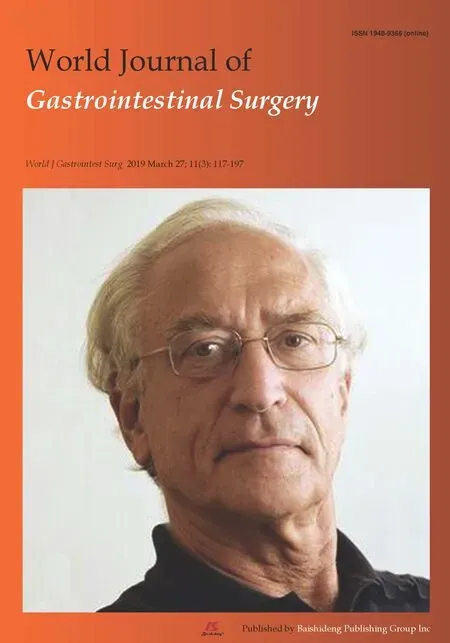Liver preservation prior to transplantation:Past,present,and future
Marcio F Chedid,Marcelo A Pinto,Jose Felipe G Juchem,Tomaz J M Grezzana-Filho,Cleber R P Kruel
Abstract
Key words: Liver transplantation;University of Wisconsin preservation solution;Institute Georges Lopez preservation solution;Celsior preservation solution;Histidine-tryptophanketoglutarate preservation solution;Dymamic preservation;Normothermic ischemia;Normothermic preservation;Hypotermic machine preservation;Static cold prreservation
BACKGROUND
Beginning in 1963,Dr.Thomas E.Starzl performed the first series of successful liver transplants (LTs) at the University of Colorado in Denver,United States[1].In the 1960s and 1970s,the results of LT were dismal with only a few transplants performed worldwide.Immunologic impairments were major barriers to the long-term success of LT until 1979,when Sir.Roy Calne,a British surgeon largely involved in the establishment of the concept of brain death,pioneered the use of cyclosporine in kidney,pancreas,and LTs[2-4].
Liver preservation was also a barrier to the progress of LT until the late 1980s.In 1988,Belzer's group reported a successful LT using the University of Wisconsin preservation solution (UW)[5].UW has replaced EuroCollins solution and allowed prolonged cold ischemia time and safer preservation of liver,kidney,and pancreas allografts,thus contributing to the improvement of transplant outcomes.
CURRENT LIVER PRESERVATION TECHNIQUES
Although UW is still considered the standard of care for organ preservation in the United States and in several countries worldwide,Adamet al[6]have recently reported similar LT outcomes using the Institut Georges Lopez-1 preservation solution (IGL-1)and UW.The study was a report from the European Liver Transplant Registry and compared the results of LT in relation to liver preservation using four different preservation solutions:UW,IGL-1,Celsior solution,and histidine-tryptophanketoglutarate preservation solution (HTK).The results of LT using UW and IGL-1 were slightly superior to those obtained with HTK,especially in the setting of prolonged cold ischemia time[6].A recent meta-analysis also revealed similar posttransplant outcomes among liver allografts preserved with UW,Celsior,IGL-1,and HTK[7].Recently,in a series of 100 consecutive LTs using IGL-1,our group identified prolonged warm ischemia time as the only adverse prognostic factor for allograft survival[8].
In kidney transplant,IGL-1 has also produced results similar to those obtained with UW[9].Our group also pioneered in the successful use of IGL-1 in human pancreas transplant[10].
Static cold storage has been the standard of care for graft preservation in liver,kidney,and pancreas transplants worldwide.High-risk lung allografts have been preserved dynamically (normothermicex-vivolung perfusion),with post-transplant outcomes similar to those of conventionally preserved lungs[11].Recently,dynamic preservation has also been used to preserve liver and kidney allografts.There are three different methods of dynamic preservation:normothermic machine perfusion(NMP),subnormothermic machine perfusion (SNMP),and hypothermic machine perfusion (HMP)[12,13].
Although associated with increased costs,NMP of liver allografts has been shown to be clinically feasible[14].NMP can be performedin situorex situand has been capable of improving laboratory perfusion parameters of marginal organs[13,14].In a recent randomized trial,normothermic preservation was associated with both a 50%lower level of graft injury and a 50% lower rate of organ discard compared with static cold storage[15].No difference was observed in bile duct complications,patient survival,or graft survival between the two groups.
SNMP is a strategy aiming to allow the use of extended criteria donor organs.It is usually performed at temperatures around 20°C.During perfusion,liver function restoration is reflected in urea,albumin,and bile production,with a tendency to improve post-ischemia parameters[16].The use of SNMP has the advantage of mitigating ischemia-reperfusion injury (IRI)[17],maintaining liver metabolism and allowing assessment of organ function prior to LT.
HMP is the most widely investigated of the three techniques,with promising results.In LT,the results for organs from donation after cardiac death (DCD)preserved with HMP have been similar to those of standard donation after brain death (DBD) organs[17].Technical variants,such as dual vessel HMP (hepatic artery and portal vein perfusion),may potentially lead to additional outcome improvements.
FUTURE PERSPECTIVES
LT with the use of DCD donor livers,also known as non-heart beating donor livers,is a strategy to face organ shortage.The use of liver allografts procured from DCD donors has contributed to a considerable increase in the donor pool in the United States and in some European countries.LT using DCD livers has provided results that are nearly as good as those obtained with the use of DBD livers[18,19].However,the occurrence of ischemic-type biliary lesions (ITBL) is a major concern when using DCD livers.The use of DCD organs increases the incidence of ITBL from 1%-3% to 10%-30%[19].HMP has been reported to reduce the occurrence of ITBL[17],what is crucial to improve clinical outcomes,since 50% of patients with ITBL require retransplantation or die.
CONCLUSION
Machine perfusion techniques are recent advances,and there is a possibility of combining them or improving them to achieve better results.The ideal perfusion temperature,the possible benefits of adding pharmacological interventions to mitigate reperfusion injury,and the impact of minor technical refinements,such as dual hypothermic oxygenated perfusion,still need to be defined.
 World Journal of Gastrointestinal Surgery2019年3期
World Journal of Gastrointestinal Surgery2019年3期
- World Journal of Gastrointestinal Surgery的其它文章
- Classification and guidelines of hemorrhoidal disease:Present and future
- Laparoscopic celiac plexus ganglioneuroma resection:A video case report
- Single incision laparoscopic fundoplication:A systematic review of the literature
- Learning curve of enhanced recovery after surgery program in open colorectal surgery
- Conduit necrosis following esophagectomy:An up-to-date literature review
- Management of pancreatic head adenocarcinoma:From where to where?
